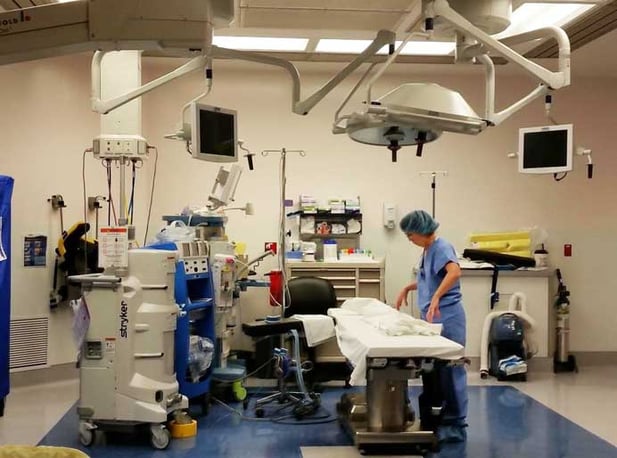In a previous blog post, I discussed the efficiency opportunity for airflow setback in healthcare operating rooms (ORs). Airflow setback is one of the more significant opportunities for energy savings in unoccupied ORs, and is included in the American Society of Healthcare Engineers (ASHE) white paper [PDF] on OR HVAC setback strategies. ASHE’s “Operating Room HVAC Setback Strategies” provides guidance that warrants consideration by facility engineers. In this post, I would like to highlight and qualify some of the important insights from ASHE regarding OR HVAC setback strategies.
OR Occupancy Schedules
The occupancy schedule of ORs is directly related to the potential energy savings from OR setback strategies. ASHE recommends that facility engineers “develop a profile of actual or expected OR occupancy to help the HVAC or mechanical designer estimate order-of-magnitude savings and determine the optimal control strategy.” This is a crucial first step for screening OR setback strategies and the hours of unoccupied operation will be needed to estimate the cost effectiveness of potential setback strategies.

Minimum Air Changes per Hour During Unoccupied Periods
In my prior post, I mentioned that per the FGI 2014 Guidelines for Design and Construction of Hospitals and Outpatient Facilities, the required minimum air changes per hour (ACH) may be reduced during unoccupied period as long as positive room pressure is maintained. ASHE mentions the important point that some codes do require a minimum ACH during unoccupied periods (e.g. the California Mechanical Code allows a minimum of 6 ACH). Ultimately, the design minimum ACH during unoccupied periods should be determined by the facility manager, engineer or RCX provider, and verified with the assistance of a NEBB or AABC certified air balancer to ensure that positive pressure is maintained at all times. Room pressure monitors should be calibrated so that the positive pressure relationship can be reliably monitored.
Energy Savings from Reduced Reheat of Supply Airflow
A considerable amount of energy savings from OR airflow setback can be realized from reduced reheat of supply airflows. During unoccupied periods when there is little or no heat gain within an OR space, a significant amount of reheat is likely needed to maintain the space air temperature setpoint. This is an important point that should be recognized by facility engineers and is not specifically mentioned by ASHE. The ASHE white paper states that “less energy is needed to maintain room temperature in ORs during unoccupied periods because equipment loads are low to non-existent when the room is not in use and, because ORs are typically located in the building core, they are not affected by temperature gains and losses in the building envelope.” It should be noted that setback/reduced supply airflow will reduce the quantity of airflow that needs to be cooled, dehumidified, and reheated. OR supply airflows are typically sized for the required space ACH, which means that the supply airflow is higher than what is needed for the cooling load. When the space heat gain decreases during unoccupied periods, the supply air reheat system will require more energy to prevent sub-cooling of the space air temperature. I agree with ASHE that less energy is needed to maintain room temperature in ORs during unoccupied periods, particularly if the rate of cool supply airflow is setback/reduced, thereby mitigating an increase in supply air reheat.
Setback Strategies for Unoccupied Healthcare Operating Rooms
Many facilities managers with whom we work are hesitant to reset airflow to their ORs. “What happens when there’s an emergency case?” is a common question. This concern can be addressed with some simple controls retrofits than include occupancy sensors and/or manual override switches. However setbacks are implemented, it is of utmost importance that the users of the space, doctors and nurses in particular, receive adequate and recurring training on what to do in the event of a procedure off hours.





